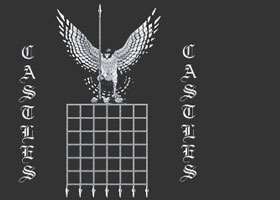Medieval Warfare - The Weapons
Medieval warfare changed as new weapons were developed. Medieval Warfare - The Crossbow
The crossbow was introduced to England by the Normans in 1066. The crossbow range was 350–400 yards but could only be shot at a rate of 2 bolts per minute. The crossbow was easy to use, requiring minimal training and required little strength to operate. But it shot too few bolts! Medieval Warfare - The Longbow
The longbow was invented in the 12th Century and the English eagerly trained their men in the skill of this new weapon of Medieval warfare. The Reason? The longbow launched arrows faster than any previous bows. A skilled longbowman could release between 10 - 12 arrows per minute. The longbow could also pierce armour at ranges of more than 250 yards. The medieval knight had no protection against the arrows of the longbow. The English gained great victories over the French at Crecy, Agincourt and Poitiers. The power of the longbow was so great that at the Battle of Crecy, in 1346, the French army was decimated. It is estimated that nearly 2000 French knights and soldiers were killed by the longbow arrows. The English lost just 50 men! The Musket
The musket was invented towards the end of the Medieval era in 1520. By 1595 all bows were ordered to be exchanged for muskets. Medieval Warfare - Siege Warfare
The Medieval era saw the construction of hundreds of castles. Prior to the Norman Invasions there were few castles in England. A totally new form of warfare was introduced to England with the castles - siege warfare. (Cities were also subject to this type of warfare.) Castles had featured in many other countries and the Romans were responsible for the invention of many siege weapons. Medieval Siege warfare tactics varied according to the role of Castle Defender or Castle Attacker. The castle owners ensured that their castles were built to withstand or combat a siege. Medieval Castles were built with access to fresh supplies from the sea. Various forms of defence including the Barbican, Portcullis, Gatehouse, Moat, Crenellations, Murder Holes etc were included in castle design. Castle attackers employed siege Warfare including starvation tactics. Castle walls could fall due to bombardment from Siege Engines such as the ballista, the Mangonel, battering ram and the trebuchet. Medieval Warfare
Medieval warfare was dependent on men and weapons. Men at Arms were first raised by the Feudal Levy and then armies were raised by taxes and loans. Eventually every country had a 'standing army'. Medieval Warfare changed from fighting pitched battles to castle siege warfare and the adoption of massive siege engines. The hand weapons used by the English moved from the short bow and arrow, to the crossbow, to the Longbow and finally to the musket. Medieval warfare was violent, frightening and constantly changing. | 
